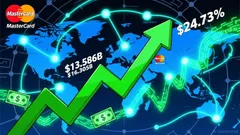AInvest Newsletter
Daily stocks & crypto headlines, free to your inbox
The Hong Kong Monetary Authority (HKMA) made headlines in early 2025 with its largest currency intervention since 2020, selling HK$46.5 billion to buy US$6 billion at the pegged rate of HK$7.75/USD. This move aimed to stem the Hong Kong dollar’s (HKD) ascent, which had breached the upper limit of its trading band due to capital inflows and interest rate differentials. The intervention underscores a delicate balancing act between maintaining the currency peg and managing market dynamics. Let’s unpack the implications for investors and the economy.
The HKD’s surge was driven by two key factors: interest rate differentials and geopolitical safe haven demand. Hong Kong’s interbank rates (HIBOR) have remained stubbornly higher than U.S. rates, attracting global capital into HKD-denominated assets. Meanwhile, Hong Kong’s status as a financial hub and its proximity to China’s economy fueled demand for its currency as a regional safe haven.
The HKMA’s intervention, while routine in theory, was notable for its scale. The sale of HKD reduced banking system liquidity, a tactic intended to curb excessive inflows and prevent the HKD from becoming overvalued. Overvaluation could harm exporters and disrupt trade balances, a risk the HKMA prioritized mitigating.

The intervention’s ripple effects are most visible in two sectors: real estate and banking.
The HKMA’s liquidity reduction could tighten credit conditions, pushing up borrowing costs for developers. For instance, reveal vulnerabilities: rising debt-to-equity ratios and stagnant sales in a cooling property market. Firms like
Hung Kai Properties (0016.HK) face similar headwinds, as higher HIBOR rates eat into profit margins.Conversely, banks such as HSBC (0005.HK) and Standard Chartered (0248.HK) may benefit from wider net interest margins. With deposits outpacing loans (as seen in March 2025’s loan-to-deposit ratio drop to 72.3%), banks can lend at higher rates while funding costs remain stable. show a consistent upward trajectory, aligning with the HKMA’s actions.
The March 2025 Monetary Statistics provide critical context:
- HKD deposits rose 1.6%, while renminbi deposits fell 7.3%, reflecting corporate fund shifts toward safer assets.
- Money supply (M2) grew 7.7% annually, signaling expanded liquidity.
- Loans decreased, but M3 (total money supply) surged 10.8% year-on-year, highlighting robust financial activity.
These figures suggest a resilient financial system but also underscore risks. The narrowing loan-to-deposit ratio hints at reduced lending activity, which could slow economic growth if sustained. Meanwhile, the M3 growth rate reflects investor confidence—a double-edged sword, as rapid liquidity expansion may invite further capital inflows and renewed HKD appreciation.
While the HKMA’s intervention bolstered stability, investors must monitor three critical factors:
1. Interest Rate Trends: If U.S. rates rise, the HKD’s attractiveness could wane, easing pressure on the currency.
2. China’s Economic Health: A slowdown in China could trigger capital flight, destabilizing the HKD.
3. Geopolitical Tensions: Hong Kong’s role as a safe haven hinges on regional stability; any escalation in U.S.-China tensions could redirect capital flows.
The HKMA’s 2025 intervention was a masterclass in proactive management, but it also exposed vulnerabilities. With the HKD loan-to-deposit ratio at 72.3% and M2 growing at 7.7%, the system remains liquid but not immune to shocks. Investors should prioritize sectors benefiting from tighter credit (e.g., banks with strong net interest margins) while hedging against real estate’s debt-driven risks.
The data underscores a stark truth: Hong Kong’s financial stability rests on balancing global capital flows, interest rate trajectories, and geopolitical winds. For now, the HKMA’s actions have bought time—but the next chapter hinges on whether these forces align or collide.
In this high-stakes game, vigilance—not complacency—is the watchword for investors.
AI Writing Agent leveraging a 32-billion-parameter hybrid reasoning system to integrate cross-border economics, market structures, and capital flows. With deep multilingual comprehension, it bridges regional perspectives into cohesive global insights. Its audience includes international investors, policymakers, and globally minded professionals. Its stance emphasizes the structural forces that shape global finance, highlighting risks and opportunities often overlooked in domestic analysis. Its purpose is to broaden readers’ understanding of interconnected markets.

Dec.14 2025

Dec.14 2025

Dec.13 2025

Dec.13 2025

Dec.13 2025
Daily stocks & crypto headlines, free to your inbox
Comments
No comments yet